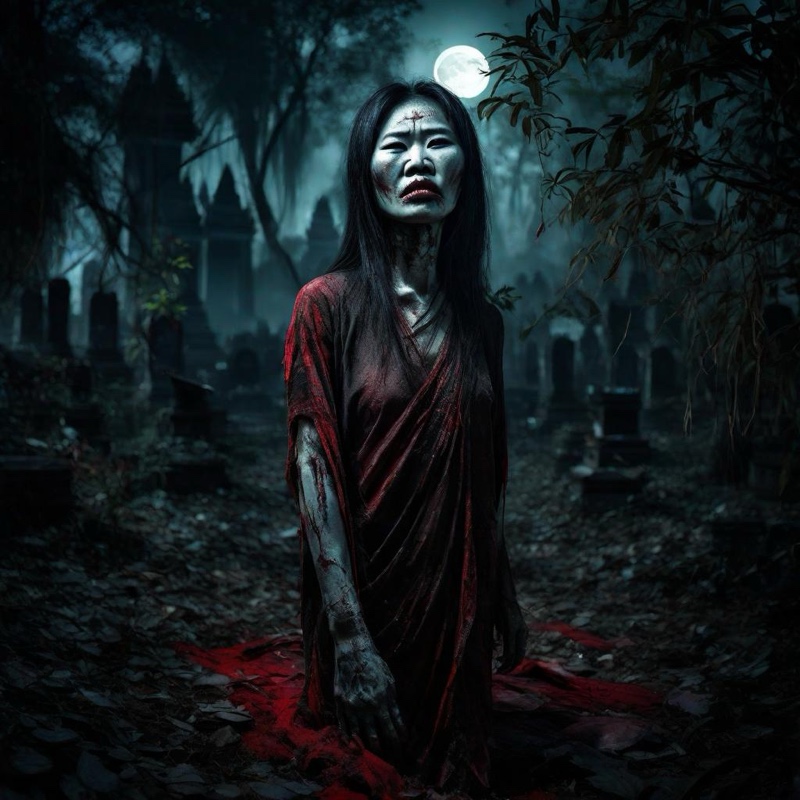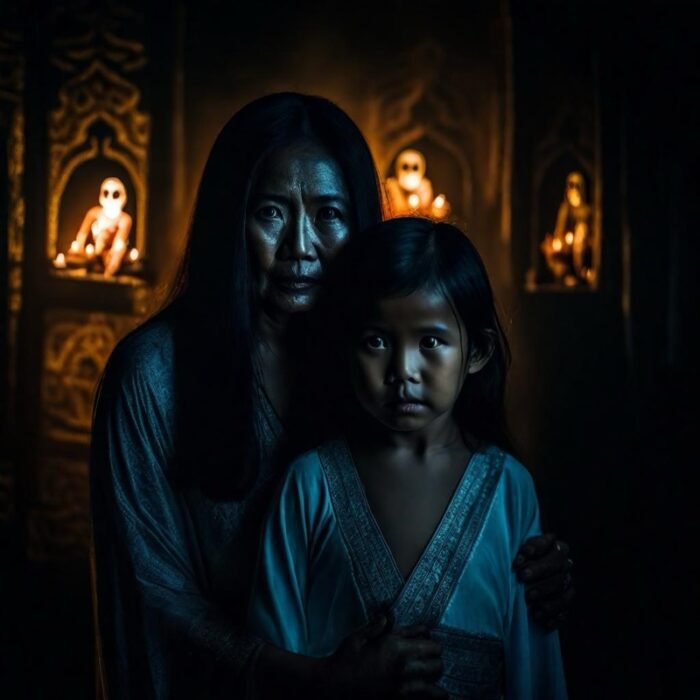
Whispers in the Wind: Exploring the Hauntings of Thai Folklore
The People of Thailand have a large number of beliefs and legends. Among these, the concept of “phi” (ผี), or ghosts, occupies a unique and fascinating space, deeply woven into the fabric of Thai society.
From Whispers to Screams: A Spectrum of Spectral Entities
Unlike many Western portrayals of ghosts, Thai “phi” encompass a diverse range of entities, each with their own characteristics and motivations.
- Vengeful Spirits: The Phi Tai Hong (ผีตายโหง), often those who died violently or tragically, are consumed by anger and seek retribution. Their presence is associated with sudden chills, unexplained noises, and misfortunes.
- Protectors of the Threshold: Dwelling within the confines of homes and offering good fortune, Phi Ban Phi Ruean (ผีบ้านผีเรือน) are considered benevolent spirits. Offerings of food and water are made to them to maintain their good graces and ensure the well-being of the household.
- Shapeshifters of the Night: Legends speak of Krasue (กระสือ), horrific female spirits with detached entrails who feed on blood and entrails. Their presence is said to be announced by the pungent smell of decaying flesh.
-
Guardians of the Wild: Deep within the lush jungles, tales whisper of Lang Suea (狼師), fearsome tiger spirits with human heads. They are believed to protect the forests and possess immense strength.
Living with the Unseen: Beliefs and Practices
The presence of “phi” influences the way many Thai people navigate their daily lives. Practices like:
- Building spirit houses (ศาลพระภูมิ – San Phra Phum): These miniature shrines offer a dwelling place for benevolent spirits, fostering a harmonious relationship with the unseen world.
- Observing respectful conduct: Certain actions, like stepping over offerings or whistling at night, are considered disrespectful to “phi” and could potentially invite misfortune.
- Seeking spiritual guidance: In times of difficulty, some may consult spirit mediums (ร่างทรง – Rang Song), individuals believed to be possessed by spirits who offer advice and perform rituals.

Thai Ghosts excerpt from a visual digital interactive story book using AI Art Created by Ajarn Spencer Due to be Published in Late 2024)
Beyond Fear: The Cultural Significance of “Phi”
While some aspects of Thai ghost lore might evoke fear or apprehension, they hold deeper cultural significance. “Phi” serve as:
- Moral cautionary tales: Stories about vengeful “phi” remind people of the consequences of negative actions and the importance of maintaining a just and ethical life.
- A connection to the past: Reverence for “phi” reflects the Thai emphasis on respecting ancestors and acknowledging the unseen forces that may influence their lives.
- A source of artistic inspiration: “Phi” inspire a diverse range of artistic expressions, from intricate temple murals to chilling ghost stories, enriching Thai cultural landscapes.
We can hence see easily, that Thailand is a land steeped in tradition, where belief in the supernatural is deeply ingrained in the culture. From the bustling streets of Bangkok to the remote villages in the countryside, stories of ghosts and spirits abound, passed down through oral tradition and immortalized in literature and art.
In this collection, we bring to life thirty distinct entities from Thai folklore, each with its own unique backstory and characteristics. From vengeful spirits seeking justice to mischievous entities causing havoc, these ghosts offer a glimpse into the mystical world beyond the veil of the living.

Image from the Interactive Digital Publication by Ajarn Spencer; Thai Ghosts. Thai Ghosts isAjarn Spencer’s first Object Media Based interactive Digital storybook due to be published l;ate 2024, through Buddha Magic Multimedia & Publications
Join us on a journey through the haunted landscapes of Thailand as we uncover the tales of Phi Tai Hong, Mae Nak, Krasue, and many more. Whether you are a seasoned ghost enthusiast or simply curious about the supernatural, “Ghosts of Thailand” promises to intrigue, chill, and captivate your imagination.
Prepare to be transported to a realm where the boundary between the living and the dead is blurred, and where the spirits of the past continue to roam the earth. Turn the page, if you dare, and embark on an unforgettable journey into the heart of Thai ghost lore.
Table of Contents
| Chapter | Chapter |
|---|---|
| 1. Phi Tai Hong | 16. Phi Laan |
| 2. Phi Krasue | 17. Phi Phong |
| 3. Phi Pop | 18. Phi Krahang Thao Hang |
| 4. Mae Nak | 19. Phi Dip Phi Pob |
| 5. Krasue | 20. Phi Khun Mae |
| 6. Phi Tai Thang Klom | 21. Phi Phraeng |
| 7. Phi Pa | 22. Phi Hua Jai Nang Takian |
| 8. Phi Phrai | 23. Phi Kong Koi |
| 9. Pret | 24. Phi Khao Thiam |
| 10. Phi Am | 25. Phi Kaan Nang Phrai |
| 11. Kuman Thong | 26. Nang Tard |
| 12. Phi Krahang | 27. Phi Ha |
| 13. Phi Chamob | 28. Phi Krahang Nang Maew |
| 14. Nang Tani | 29. Phi Khun Ramphueng |
| 15. Nang Takian | 30. Phi Krahang Nang Maew |